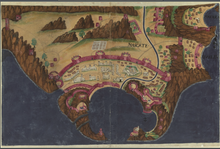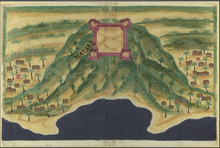Portuguese Oman

Portuguese Oman refers to the period during which the territory was under Portuguese rule, between 1507 and 1656.
The region was conquered by portuguese forces under the command of Afonso de Albuquerque in 1507, and remained under Portuguese control until they were expelt by the Ya'rubids.
History 1507–1622[]




In the early 16th century, Oman was a province of the Kingdom of Hormuz, ruled by its governors.
In 1507, the Portuguese captain-major of the seas of Arabia Afonso de Albuquerque conquered the coastal cities of Oman with a six ship squadron and about 500 men, imposing the payment of a tribute in exchange for autonomous rule.[1][2][3][4] In 1515, as Governor of India Albuquerque captured the city of Hormuz itself, by the entrance of the Persian Gulf, and erected on it the Fort of Our Lady of the Conception. Hormuz and its provinces were thus reduced to a Portuguese protectorate, and since then, Portuguese merchants and military garrisons were established on Oman, most importantly Muscat, due to its sheltered deep-water harbour.
In 1523, Sohar rebelled, but it was pacified by Dom Luís de Menezes, while Muscat and Qalhat rebelled in 1526 but were likewise pacified.[5]
Muscat was raided by Ottoman fleets in 1546, 1551, and again in 1581. The Portuguese fortified the city in their aftermath, concluding the forts Almirante (Al-Mirani) and São João (Jalali) in 1588.[6] A fort was erected at Khor Fakkan in 1621.[7]
In 1622, Hormuz was captured by Safavid Persia with the aid of the English East India Company. The Kingdom of Hormuz was dissolved and the Portuguese relocated their forces to Oman, which was placed under thr direct rule of a Portuguese captain-general, seated in Muscat. From Oman the Portuguese not only developed the trade in the region but conducted attacks on the Persian coast and English or Dutch navigation in the Gulf.
Julfar was captured by the Yarubids in 1633.[8] Sohar followed in 1643.[9] Muscat was besieged by the Yarubids in 1648, and peace treaty negotiated with the Portuguese, but the city was again attacked two years later and fell. In 1656 the Portuguese evacuated Khasab, thus putting an end to Portuguese rule in the region.
Portuguese fortresses in Oman[]
Along the Omani coast the Portugueese erected forts and installed garrisons to defend the territory from incursions from pirates, the Persians and local Arab tribes from the interior.
- Mascate – Muscat – headquarters of the Portuguese captain-general of the sea of Hormuz responsible for all Portuguese operations in Oman, the Persian Gulf and Red Sea.
- Borca – Barka
- Calaiate – Qalhat
- Cassapo – Khasab
- Curiate – Qurayyat
- Doba – Dibba
- Dubo – Dubbo
- Julfar – Julfar
- Libedia – Al Badiyah
- Lima –
- Madá – Madha
- Matara – Muttrah
- Mocombira – Mocombi
- Orfação – Khor Fakkan
- Sibo – Seeb
- Soar – Sohar
- Quelba – Kalba
Gallery[]

Libedia

Quelba

Orfação

Curiate

Sibo

Dibba

Soar
See also[]
References[]
- ^ Barros, João de, Década Segunda da Ásia p. 95
- ^ Barros, pg 101
- ^ Afonso de Albuquerque, in Cartas de Afonso de Albuquerque, Seguidas de Documentos que as Elucidam Volume I. Raymundo António de Bulhão Pato, Lisboa, Typ. da Academia Real das Sciencias de Lisboa 1884, pp. 9–10
- ^ Afonso de Albuquerque, in Cartas de Afonso de Albuquerque, Seguidas de Documentos que as Elucidam Volume I. Raymundo António de Bulhão Pato, Lisboa, Typ. da Academia Real das Sciencias de Lisboa 1884, p. 10
- ^ Fort of Nossa Senhora da Conceição de Hormuz, in Fortalezas.org
- ^ Ana Catarina Gonçalves Lopes, Jorge Manuel Simões Correia: DAS FORTIFICAÇÕES PORTUGUESAS EM MASCATE: ANÁLISE MORFOLÓGICA E TERRITORIAL in GENIUS LOCI – LUGARES E SIGNIFICADOS | PLACES AND MEANINGS – VOLUME 2 by Centro de História de Além-Mar, Nova University of Lisbon, p.223
- ^ Fort of Nossa Senhora da Conceição de Hormuz, in Fortalezas.org
- ^ Davies 1997, p. 59.
- ^ Beck 2004.
- Davies, Charles E. (1997-01-01). The Blood-red Arab Flag: An Investigation Into Qasimi Piracy, 1797–1820. University of Exeter Press. ISBN 978-0-85989-509-5. Retrieved 2013-11-11.
- Beck, Sanderson (2004). "East Africa, Portuguese, and Arabs". Middle East & Africa to 1875. Retrieved 2013-11-11.
- History of Oman
- Former Portuguese colonies






